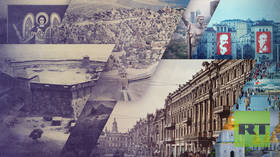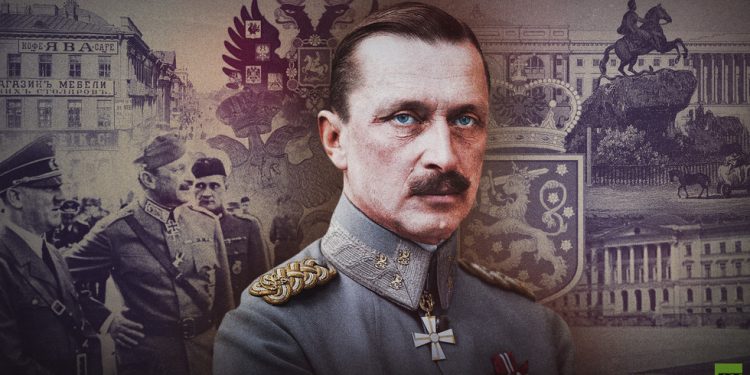80 years ago Marshal Carl Gustaf Mannerheim became President of Finland. An extraordinary person, he was a military commander and statesman in both Russia and Finland, and left behind a controversial legacy in each country.
Beyond their 790-mile shared border and 108 years of being part of the same state, Moscow and Helsinki have other things in common: their complicated attitudes toward Carl Gustav Mannerheim. Once hailed as a hero in both countries, Mannerheim was a Russian army officer who became Finland’s president during the Second World War. His legacy is fraught with ambiguity and marked by countless lost lives, both Russian and Finnish. This article explores who Mannerheim was and why monuments dedicated to him are frequently splashed with red paint on both sides of the Finland-Russia border.
An officer in St Petersburg
The Mannerheims were an old and well-known merchant and later aristocratic family in Sweden. An offspring of this family moved to Finland, part of Sweden at the time. The family quickly got used to life in Finland but, in terms of self-perception and language, the Mannerheims remained Swedish.
However, in 1809, Russia annexed Finland. Carl Erik Mannerheim, a statesman and great-grandfather of Carl Gustaf Mannerheim, held negotiations with Russian Emperor Alexander I. So, when Carl Gustaf Mannerheim was born in 1867, it seemed that his fate was sealed.
Despite being born into such a renowned family, Carl Gustaf was not pampered in his childhood. His mother tried to bring him up strictly so he would grow up to be a brave man. His father, however, was a careless and irresponsible man who squandered a fortune and left his family to live with his mistress.
Carl Gustaf’s mother then sold the family’s large estate and possessions and moved to a smaller estate, where she died in 1881. His guardians sent him to a regular cadet school. The boy got into trouble all the time and was often locked in the school’s punishment cell, and some relatives were convinced a sad fate awaited him.
However, it turned out that the young man was also quite ambitious. Not wanting to graduate from a bad educational institution and to spend his life in some garrison, he demonstrated great perseverance and got into the elite Nikolaev Cavalry School.
He studied diligently, but diligence was not enough to get a good position. This is when he resorted to old family ties, which the impoverished but ambitious Mannerheim hadn’t forgotten about. Through the recommendation of his godmother, Baroness Skalon, he was transferred to the Cuirassier Cavalry Guard regiment, composed of the crème de la crème of the aristocracy.
The Cuirassier Cavalry Guard was an elite court regiment. It didn’t participate in combat but the regiment was the best place to acquire useful connections. Soon, Mannerheim arranged a profitable marriage for himself. He now had money and a good position, and even the breakup of the marriage did not particularly upset him, since he was more interested in horses than in family life. Expenses were a bigger problem. The times demanded that he get a grip on his finances, but Carl Gustav was not a businessman and his debts only grew. Then, the 37-year-old’s life suddenly acquired new meaning with the start of the Russo-Japanese War.
Russia lost the war and Mannerheim fell seriously ill during service, but had proven a very capable military man, and commanded cavalry detachments composed of Asian horsemen – the Manchus and the Tungus.
The war motivated Mannerheim to start a real military career. After the campaign, he was engaged in intelligence and research activities in Central Asia, and returned with useful news and intelligence information. His position was fully restored, he was received by Emperor Nicholas II and was appointed commander of a regiment of dragoon guards and then of a cavalry brigade.
Armed with these experiences, Mannerheim went to fight in the First World War.
Combat during WWI was very different from the raids by small cavalry detachments during the war with Japan. This time, Mannerheim commanded regiments that fought along a wide front and he had a chance to demonstrate his best qualities. In heavy fighting in southeastern Poland, he proved to be an excellent tactician who was not only brave and determined, but also prudent. Battles, military decorations, and a growing reputation – such was his life at the time.
Meanwhile, the Russian revolution had occurred in Petrograd, later Leningrad and now St Petersburg.
In the spring of 1917, the monarchy in Russia fell. Emperor Nicholas II did not fight for elusive power and abdicated.
Mannerheim put in a lot of effort to become an officer of the Russian Empire. He spent his youth in St Petersburg, shed blood for Russia in two wars, served as an intelligence officer and researcher and made a brilliant court and military career. But, at the age of 50, his fate took an unexpected turn and, from then on, his life became quite different.
A general during the Finnish civil war
1917 was a turning point not only for Russia but for Finland as well. After the fall of the Russian Empire, Finland declared independence. However, different parts of Finnish society had different ideas about the country’s future.
Just like Russia, Finland suffered a major split. Its revolutionaries and supporters of leftist ideas became known as the ‘Reds’ and were opposed by the nationalists, the ‘Whites.’ As is usually the case in such situations, there were many parties, but they soon formed two sides.
In Russia, events developed rapidly. A new revolution overthrew the amorphous and almost incapacitated Provisional Government, and a new political force came to rule the country– the Bolshevik Party.
At that time, around New Year 1918, Mannerheim returned to Finland.
A little earlier, in Petrograd, he had met with the head of the French military mission. He wanted to get weapons and ammunition from Paris to fight the Finnish Reds. He also still counted on WWI allies at that time. Meanwhile, in Finland, local right-wing politicians turned to Germany for help.
Finland’s independence was already recognized by the major world powers, including Germany, France, and the Bolshevik government. But the country was torn by strife. The Red Finns were supported by the Bolsheviks from Russia, while the Whites joined forces with Germany.
The German troops included a Finnish Jaeger battalion. The Germans formed a unit of 1,200 men who supported Finnish independence. They mostly held ultra-right and strongly anti-Russia views, and were even Russophobic. They looked on Mannerheim with suspicion. Generally, relations between the Finns who’d served in the Russian army and the members of the Jaeger battalion weren’t very warm: ‘Russian’ Finns called the Germans feldwebels (lower-ranking) and each side didn’t hide its contempt towards the other.
However, politics placed Mannerheim and the ‘Jaegers’ in the same boat. On returning to Finland, he became the uncontested military leader of the local White movement, which initially drew from the city of Oulu, north of the densely populated areas off the coast of the Gulf of Finland. There were already 38,000 people in the ‘suojeluskunta,’ the paramilitary detachments of the White Guard, but they lacked a core, and that’s when it was decided that the Jaeger battalion could help.
Interestingly, Mannerheim himself held moderate political views. He told journalists “Our goal is to cleanse Finland of anarchy.” Asked what would happen after victory, Mannerheim said that it was a difficult question, and noted that he was speaking only on his own behalf. In general, his position resembled the views of the leader of the Russian White movement, General Anton Denikin. But while Denikin lost his war, Mannerheim succeeded in winning his.
Mannerheim led the Whites’ offensive in the southern direction. His operations against the Reds were in line with German interests, and the Germans planned to directly intervene in the war. At the time, WWI was ongoing and the Germans hoped to get to Petrograd via Finland.
In April 1918, German troops arrived in Helsingfors (Helsinki), the capital of Finland. Finland’s Red movement was crumbling to pieces.
The brutality of the Finnish Civil War changed Mannerheim. During the fighting, Finns killed Finns, a lot of blood was shed, and even more people died in concentration camps or were shot. The Jaegers conducted ruthless political purges, but so did the regular units. People suspected of sympathizing with the Reds were held in terrible conditions, many executed or dying in prison. In Vyborg, the victors also carried out ethnic cleansing.
Vyborg is a city on the Russia-Finland border with a diverse history. Today it belongs to Russia and tourists visit it to see typical Western burgher houses, churches, even a castle. This Western architecture is interspersed with great parks from the times of the Russian Empire and buildings in the Soviet Stalinist Empire style. In 1918, the city was also diverse ethnically – Russians, Finns, Germans and many others resided there and got along quite well. But, having seized Vyborg, the Finnish Whites engaged in a massacre. Several hundreds were executed, most of them Russians. One retired Russian officer even went out to greet the Finnish Whites in uniform and with a bouquet of flowers. He was shot. The dead were robbed. The massacre was carried out by young recruits from the north of Finland who considered all Russians communists and all communists worthy of execution without trial.

Mannerheim was concerned about the massacre in Vyborg but was more worried about relations with his own army and his own future. He did not forget that he had been a Russian officer for 30 years, and planned to organize a campaign to Petrograd. This idea was in line with his great ambitions. Red Finland collapsed, but Russia remained. Finland was a small country, but Mannerheim was in charge of a victorious army. If he managed to enter Petrograd with his army, he would become a world-class politician.
However, at this point Mannerheim encountered problems from all sides. Of course, the Reds would fiercely resist the great march on St Petersburg, and fighting Soviet Russia – which was partially in ruins but still a huge country – was an extremely risky endeavor. In Finland, radicals proposed to seize Karelia, relying on the alleged Karelo-Finnish brotherhood, and were not interested in St Petersburg. The Germans already found a common language with the Bolsheviks, and the war could interfere with the peace treaty. Finally, Finnish moderates did not want to fight at all – the Bolsheviks recognized Finland’s independence, what else mattered?
Moreover, Finland was in a difficult economic situation, and foreign policy was of secondary importance for most people. Mannerheim spent some time as a regent, or temporary ruler, of Finland. In 1919, he ran for president but was defeated by university professor Kaarlo Juho Ståhlberg. In 1920, a peace treaty was signed in Tartu and, over the next few years, Russia and Finland had quite stable relations. As for Gustav Mannerheim, he left big politics for a long time.
Mannerheim won the Finnish Civil War. However, this victory cost the country dearly and stained his reputation. The military losses of the two sides amounted to over 10,000 people (3,460 Whites and 6,966 Reds). Over 11,000 supporters of the Reds died in concentration camps and more than 7,000 Reds (and up to 1,500 Russians) were shot during political and ethnic cleansing. Many were arbitrarily sent to concentration camps just because they had relatives among the Reds. Even today, many people in Finland react strongly to these events. In the city of Tampere, which was severely damaged during the assault of the Whites and during the repressions, the monument to Mannerheim is sometimes splattered with paint and the mass graves of the Whites are vandalized with inscriptions like “Executioners” and “Punishers.”
For a long time, Mannerheim stayed away from politics. He was engaged in social activities, traveled, and hunted. But in 1931, he was called back to join the leadership of Finland.
This time, Mannerheim was appointed chairman of Finland’s defense council. He reformed the armed forces and oversaw the construction of a series of fortifications on the Karelian Isthmus, which was informally called the Mannerheim Line.
A Field Marshal of the Axis
Mannerheim believed that sooner or later, Finland could become involved in a conflict with the Soviet Union. Indeed, in the late 1930s, tensions between Moscow and Helsinki indeed started to increase.
The USSR believed that Finland could become a springboard for aggression against the Soviet Union. At that time, Vyborg was part of Finland, and Leningrad (throughout its history, St. Petersburg bore different names –first it was renamed Petrograd, and in Soviet times it was renamed Leningrad, after Bolshevik leader Vladimir Lenin) was quite close to the border. The Soviet Union attempted to claim large parts of Finnish territory, primarily the Karelian Isthmus, in exchange for territories in Karelia that were less significant for the USSR. However, naturally, Finland was primarily concerned about its own security and was not eager to transfer territory to the Soviet Union, particularly those areas where it had built new fortifications and which were densely populated.
As a result, in November 1939, the USSR started a war against Finland, planning to resort to force where diplomacy had failed.
Mannerheim headed Finland’s armed forces. The war of 1939-1940 was his finest hour as a commander. Under his firm and energetic leadership, the advancing Soviet troops suffered extremely heavy losses. The USSR’s inability to cope with Finland, which was inferior to it in terms of population and military power, was a painful blow to the country’s prestige. As a result, although the Soviet Union achieved its initial military goals the whole world talked about Finland’s tactical victories, and 105 days of war contributed more to the glory of the defeated than of the victors.
However, despite its brilliant success on the battlefield, Finland lost the war and had to accept less advantageous peace conditions than those that had been offered to it by the USSR prior to the war.
No one had complaints against Mannerheim personally – he fought as best he could and achieved the best possible results. However, Finland’s political leadership had nothing to brag about: Finland suffered heavy losses (especially for such a small country) only to lose the very territories that the Soviet Union had initially demanded.
But, while the Finns considered the Winter War (as the war of 1939-1940 is often called) a war of independence, the next conflict was quite different.
Searching for allies, Finland played the trump card and found a new patron – Adolf Hitler.
The alliance between the Third Reich and Finland is an uncomfortable topic for many authors who write about it.

Frankly, it does not fit into the story of the proud and freedom-loving country that only sought to protect its freedom. However, in reality Finland formed this alliance because it not only wanted revenge, but also hoped to acquire new territories.
Mannerheim was part of a narrow circle of people who were responsible for making key decisions in Finland. The country was part of the general plan of the Reich’s offensive on the USSR, and it would be a lie to claim that Helsinki did not want war and was dragged into it against its will. In reality, the deployment of German troops in Finland started immediately after the start of the war against the USSR.
On June 22, 1941, Finnish aviation began mining USSR waters and Wehrmacht divisions were deployed to attack the Soviet Union from Finnish territory.
The most painful issue concerned Leningrad/St Petersburg. Hitler’s plan was quite clear and unambiguous: he wanted to completely destroy the city. The Finns were supposed to play a significant role in the offensive on Leningrad. They approached Leningrad from the front, via the Karelian Isthmus that they’d lost in 1940, but also advanced from the north, along the shore of Lake Ladoga. East of Leningrad, they were supposed to meet advancing German troops.
Initially, the offensive of the Finns and Germans was quite successful. They were able to move deeper into the territory of the USSR. For Russia, it was extremely difficult to resist the Wehrmacht, which at the time was the most powerful army in the world. The Finns drove the Russians out of the Karelian Isthmus.
Mannerheim’s subsequent actions are often described as an attempt to avoid a close alliance with the Germans and not be involved in the destruction of Leningrad, where he spent his young years. Some say that the Finns did not attack the city due to the commander’s sentimental feelings, humanistic considerations, etc. In fact, the reasons for stopping the offensive were quite prosaic and concerned the country’s military forces. The offensive did not look promising for the Finns. They had no means to encircle Leningrad and engage in street battles, and were lacking in shells for heavy artillery, in artillery equipment, and in human reserves. Obviously, in such conditions the Russians would have fought with insane ferocity – like they did on the southern outskirts of Leningrad, where the Germans advanced. The Finnish army was “short of breath” – it would not withstand a prolonged meat grinder. And most importantly, the Finnish troops continued their offensive, but bypassing Lake Ladoga. The encirclement of Ladoga by the Finns and Germans cut off supply routes to Leningrad, and then Hitler proceeded to implement his diabolic plan of destroying the necessary infrastructure and starving and freezing the city’s population to death. And the Finnish army implemented its part of this plan.
However, the plan failed. As the circle almost closed in east of Lake Ladoga, Soviet troops counterattacked further south, forcing the Germans to retreat from Tikhvin. The land route to Leningrad was still cut off, but the Russians had a long stretch of Lake Ladoga at their disposal. As a result, Russians could slowly and with great difficulty evacuate people from Leningrad and bring food, fuel, and ammunition into the city. Finnish troops got stuck at the turn of the Svir River and couldn’t move deeper into Russian territory.
By the end of 1941, the Finnish army found itself at a dead end. It had achieved brilliant success by moving deep into USSR territory and even captured territories that had never belonged to Finland; the Germans advanced towards Murmansk and the railway running south from Murmansk was cut off.
But all of this was quite useless. Making a great effort and bearing great losses, the Russians were able to retain control over Leningrad; the railway resumed operation, bypassing the section that was cut off; Murmansk remained under Russian control and polar convoys of the Allies unloaded in its port.
Meanwhile, in the occupied territory, hell was raging. The photo in which exhausted children stand behind barbed wire on which hangs a sign that reads “Entering the camp and talking by the wire is prohibited under threat of execution” was taken not in a Nazi but in a Finnish concentration camp. It was assumed that the non-Finnish population would be deported after the war. By April 1942, up to a third of the entire population of the occupied territory was in camps – which was more than 24,000 people. According to various sources, up to 7,000 of them died. The Finnish side handed over some of the prisoners and Jews to the Nazis, and other Jews were used for hard labor in Finland. As for the prisoners, out of the 64,000 Soviet soldiers captured by the Finns, 19,000 died. In his memoirs, Mannerheim mentions the plight of the prisoners and his concern for their situation. However, he scarcely mentions the imprisonment and mass deaths of civilians in camps.
The Finnish army continued to uphold the northern flank of the siege of Leningrad.
However, the only thing Helsinki could do was wait for the Wehrmacht to win the war. And the Wehrmacht did not succeed in this. In 1942, a German offensive was supposed to isolate Leningrad completely, cutting off all supply routes, including Lake Ladoga. The Finns were prepared to do their part, and torpedo boats and German Siebel combat ferries appeared on the lake, but the offensive never took place: the German group was attacked by new Russian divisions that came to the rescue of Leningrad. The parties neutralized each other.
Almost 650,000 people died from shelling and starvation during the siege of Leningrad. Mannerheim directly participated in this hecatomb, helping the Wehrmacht strangle the city with which he was tied in so many ways.
At the turn of 1942-43, a powerful German group was defeated in the far-off city of Stalingrad. It became clear that the Reich would not win the war. Finland faced the menacing prospect of being defeated, so it started looking for ways to escape from the sinking ship.
A decision had to be made quickly. In early 1943, the blockade of Leningrad was broken on the southern flank. The following year, the Germans were finally driven out of the city. Helsinki was looking for a compromise with Moscow. The Russians demanded the internment of German troops in Finland, the payment of reparations, and a return to 1940 borders, but Finland refused.
In the summer of 1944, the Russians launched an offensive on the Karelian Isthmus and broke through Finnish defenses. Russia regained control over Vyborg and the offensive threatened to spread further into the depths of Finland.
The president
Due to the catastrophic situation at the front, Finnish President Risto Ryti resigned. On August 4, 1944, Marshal Mannerheim became President of Finland.
The military man’s main task as president was to achieve peace.
In September 1944, Finland accepted Russia’s demands and, in exchange, was allowed to withdraw from the war. German troops in Finland were defeated in the course of the short but fierce Lapland War. On leaving, the Wehrmacht units burned down the part of Finland that they could lay their hands on – the city of Rovaniemi was burned to the ground.
The war was over.
By that time, Mannerheim was a sick and exhausted man. He suspected conspiracy plots against himself and feared that he would be tried for the events of 1941. Particularly since President Ryti was tried and sentenced to several years in prison. By the way, there were indeed some people on the Soviet side who would have preferred to have Mannerheim (as well as Ryti) hanged. However, Stalin did not want to go ahead with this and, as a result, Ryti was imprisoned for some time and that was the end of it.
Carl Gustav Mannerheim resigned in March 1946. He spent the rest of his days traveling and writing his memoirs. In 1951 he finished his memoirs and his health sharply deteriorated. On January 27, 1951, Mannerheim died.
Mannerheim remains one of the key figures in Finland’s history but is also quite an ambiguous one. The atrocities of the Finnish Civil War have not been forgotten and, during WWII, the marshal’s role was quite controversial. While in the Winter War Finland preferred to fight rather than surrender, in 1941 it entered into an alliance with the most odious political regime in history and bore heavy losses. However, Finns generally consider this as merely a few “dark spots” on the sun.
For Russians, however, the story is more complicated. Mannerheim is remembered in different ways – as a man who started out as a brilliant military and intelligence officer then turned into a cruel commander during the Finnish Civil War, in which he did not particularly care about the actions of his people, and during WWII he became Hitler’s ally and was directly responsible for one of the greatest humanitarian catastrophes and war crimes in world history. Major politicians – especially in such a turbulent era as the first half of the 20th century – are rarely unambiguous figures, especially when their names are inscribed in the histories of different peoples, and Carl Gustaf Mannerheim was living proof of this.


